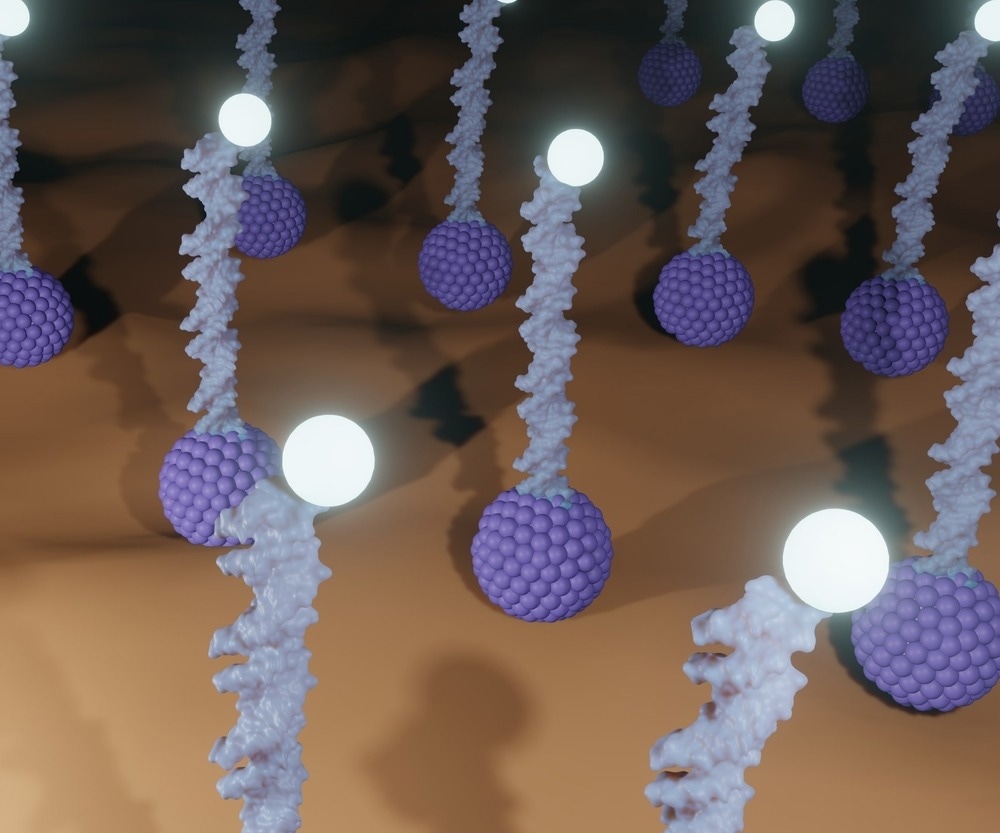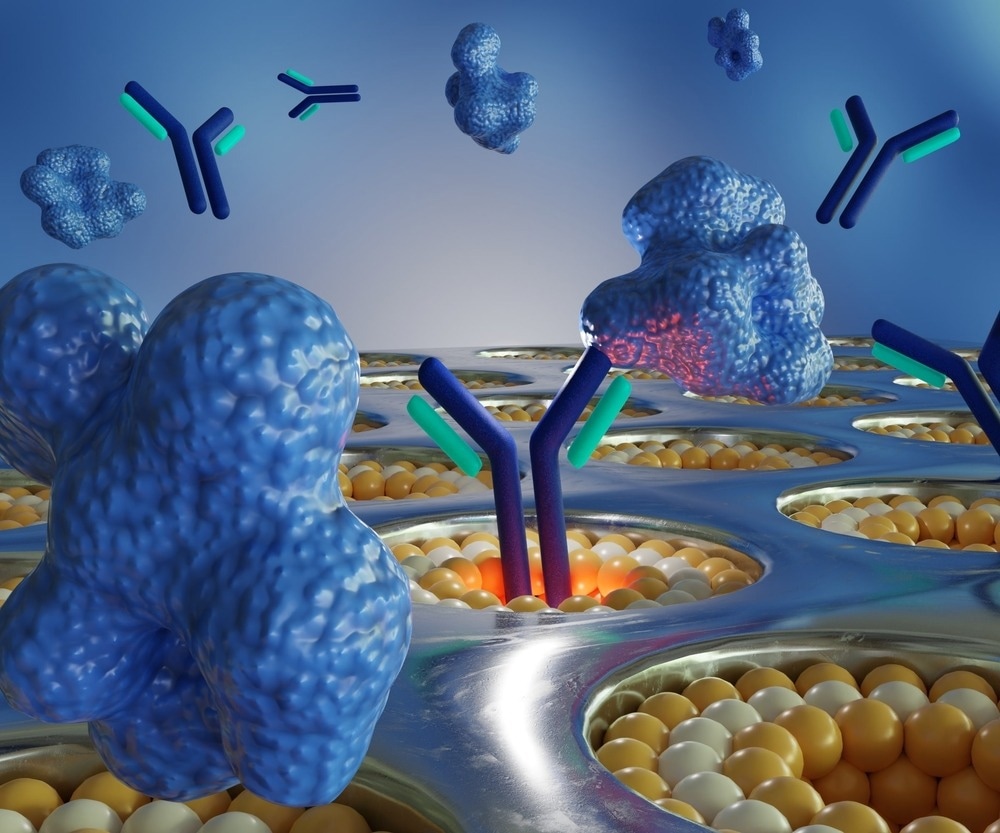This article was updated September 2023.
A biological sensor (biosensor) is an analytical device that detects chemical or biological reactions using biological components. Biosensors are utilized in a wide variety of applications, such as medical diagnostics, environmental monitoring, process monitoring, the food industry, and the military.

Image Credit: Love Employee/Shutterstock.com
Biosensors: Overview
A biosensor consists of a biological element or bioreceptor (an enzyme, antibody or nucleic acid) and a transducer. The component behaves like a sensor and reacts with the analyte to generate an electrical, optical, or thermal signal. The transducer converts it to a measurable electrical signal.
Several substances can be used as the bio-element, including nucleic acids, enzymes, antibodies, plant proteins or lectins, or complex materials such as tissue slices, microorganisms, and organelles.
Biosensors need to be compact but an appropriate size for regular use. Additionally, it must be manufacturable in large numbers at a low cost and must provide rapid results within the timescale of a process or diagnostic test. Furthermore, it must be economical, self-calibrating, robust, specific, portable, simple, and easy to use.
Selectivity
One of the essential properties of a biosensor is its selectivity - the availability of the bioreceptor to detect the specific analyte in a sample that contains other admixtures and contaminants.
Selectivity is shown, for example, by the interaction of an antigen with an antibody, which is immobilized on the surface of a transducer. A solution, usually a buffer containing salts as well as the antigen, is exposed to the sensor, with only the antibody reacting with the antigen.
Reproducibility
Reproducibility is the ability of a biosensor to generate identical responses when experiments are repeated. It is characterized by the precision and accuracy of the transducer and electronics in the biosensor.
Reproducible signals deliver high consistency and robustness to the results collected via the response of the sensor.
Stability
Stability is incredibly important; it is the degree of susceptibility to ambient disturbances in and around the biosensor system. Such disruptions could cause drift in the output of the biosensor under measurement, causing errors in the measurement concentration as well as issues with precision and accuracy.
Stability is a crucial feature in applications where the biosensor might require long incubation steps or continuous monitoring. It can be affected by the affinity of the bioreceptor - the degree to which the analyte binds to the bioreceptor.
A biosensor with high affinities fosters either strong electrostatic bonding (the electrostatic attraction between ions or molecules) or covalent linkage of analytes, which strengthens the stability of the sensor.

Image Credit: Love Employee/Shutterstock.com
Sensitivity
In medical or environmental monitoring applications, biosensors are required to detect analyte concentrations in trace amounts in a sample, and so must be incredibly sensitive. A biosensor’s limit of detection is the minimum amount of analyte it can detect, which governs its sensitivity.
Linearity and Resolution
This property shows the accuracy of a measured response to a straight line and is associated with the resolution of the biosensor and the range of the analyte concentration under test.
Resolution is the smallest change in analyte concentration required to bring a change in the biosensor’s response.
A high resolution is necessary, as most biosensor applications require analyte detection and measurement of the concentration of analyte over a broad working range.
Types of Biosensors on the Market
Several types of biosensors are available on the market for research and industry, including paper-based devices, pathogen detection sensors, non-invasive sensors, electrochemical affinity sensors, and personal blood glucose analyzers.
Nanotechnology has also provided new and innovative approaches for biosensing, providing new devices for the biomedical, food, and environmental industries, to name but a few critical sectors where these sensors are employed. Nanoscale biosensor systems present significant opportunities for scientists.
Many custom-made and off-the-shelf biosensors are available on the market currently, with new advances regularly being made in the field of biosensing, providing highly accurate, sensitive, reproducible, stable, and reproducible results.
In Summary
Many properties are crucial to a biosensor’s proper functioning. This is especially important as some of the main applications are in medical diagnostics and point-of-care monitoring of treatment and disease progression.
Other applications include food and drink monitoring and forensics. A biosensor must have properties such as robustness, cost-effectiveness, specificity, sensitivity, good stability, and high selectivity. New and innovative biosensors provide significant benefits for scientists working in multiple critical industries.
References and Further Reading
Sezgintürk, M.K (2020) Commercial Biosensors and Their Applications [online] sciencedirect.com. Available at: https://www.sciencedirect.com/book/9780128185926/commercial-biosensors-and-their-applications
Bhalla, N et al. (2016) Introduction to biosensors Essays Biochem. 60:1 pp. 1-8 [online] ncbi.nlm.nih.gov. Available at: https://www.ncbi.nlm.nih.gov/pmc/articles/PMC4986445/
Elprocus (2023) What is a Biosensor : Types & Its Applications [online] elprocus.com. Available at: https://www.elprocus.com/what-is-a-biosensor-types-of-biosensors-and-applications/
Disclaimer: The views expressed here are those of the author expressed in their private capacity and do not necessarily represent the views of AZoM.com Limited T/A AZoNetwork the owner and operator of this website. This disclaimer forms part of the Terms and conditions of use of this website.